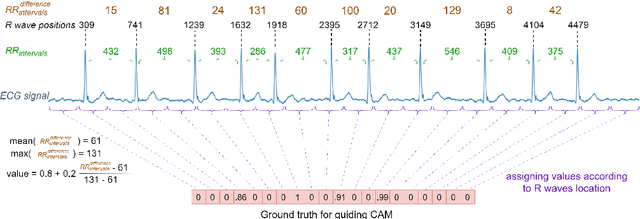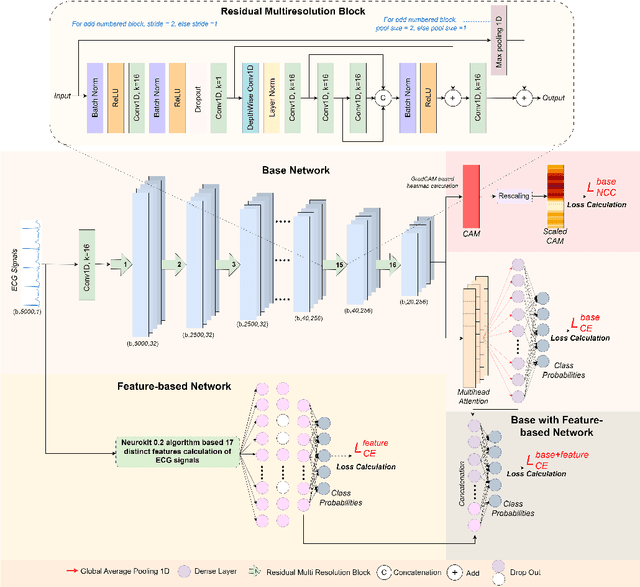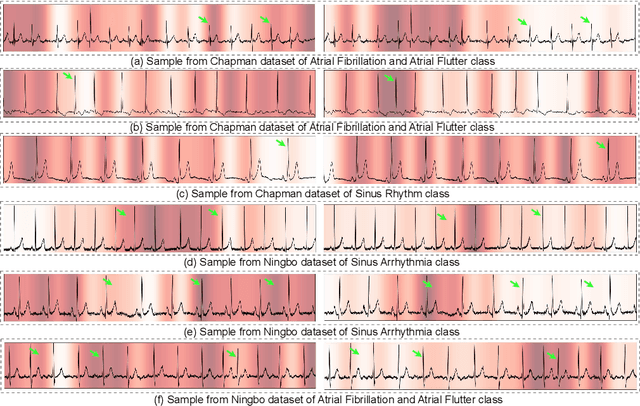Ecg
Papers and Code
A Deep Learning Pipeline Using Synthetic Data to Improve Interpretation of Paper ECG Images
Jul 29, 2025Cardiovascular diseases (CVDs) are the leading global cause of death, and early detection is essential to improve patient outcomes. Electrocardiograms (ECGs), especially 12-lead ECGs, play a key role in the identification of CVDs. These are routinely interpreted by human experts, a process that is time-consuming and requires expert knowledge. Historical research in this area has focused on automatic ECG interpretation from digital signals, with recent deep learning approaches achieving strong results. In practice, however, most ECG data in clinical practice are stored or shared in image form. To bridge this gap, we propose a deep learning framework designed specifically to classify paper-like ECG images into five main diagnostic categories. Our method was the winning entry to the 2024 British Heart Foundation Open Data Science Challenge. It addresses two main challenges of paper ECG classification: visual noise (e.g., shadows or creases) and the need to detect fine-detailed waveform patterns. We propose a pre-processing pipeline that reduces visual noise and a two-stage fine-tuning strategy: the model is first fine-tuned on synthetic and external ECG image datasets to learn domain-specific features, and then further fine-tuned on the target dataset to enhance disease-specific recognition. We adopt the ConvNeXt architecture as the backbone of our model. Our method achieved AUROC scores of 0.9688 on the public validation set and 0.9677 on the private test set of the British Heart Foundation Open Data Science Challenge, highlighting its potential as a practical tool for automated ECG interpretation in clinical workflows.
Design of a Noval Wearable ECG Monitoring Device
Jul 23, 2025The aim of this project is to develop a new wireless powered wearable ECG monitoring device. The main goal of the project is to provide a wireless, small-sized ECG monitoring device that can be worn for a long period of time by the monitored person. Electrocardiogram ECG reflects physiological and pathological information about heart activity and is commonly used to diagnose heart disease. Existing wearable smart ECG solutions suffer from high power consumption in both ECG diagnosis and transmission for high accuracy. Monitoring of ECG devices is mainly done by data extraction and acquisition, pre-processing, feature extraction, processing and analysis, visualisation and auxiliary procedures. During the pre-processing of the information, different kinds of noise generated during the signal collection need to be taken into account. The quality of the signal-to-noise ratio can usually be improved by optimising algorithms and reducing the noise power. The choice of electrodes usually has a direct impact on the signal-to-noise ratio and the user experience, and conventional Ag/AgCl gel electrodes are not suitable for long-term and dynamic monitoring as they are prone to skin irritation, inflammation and allergic reactions. Therefore, a completely new way of combining electrodes and wires will be used in the report. The electrodes and wires are cut in one piece from a silver-plated fabric. The wire portion is cut into a curved structure close to an S shape to ensure that it has good ductility for comfort and signal integrity during daily movement of the garment.
Detection of Intelligent Tampering in Wireless Electrocardiogram Signals Using Hybrid Machine Learning
Jul 08, 2025With the proliferation of wireless electrocardiogram (ECG) systems for health monitoring and authentication, protecting signal integrity against tampering is becoming increasingly important. This paper analyzes the performance of CNN, ResNet, and hybrid Transformer-CNN models for tamper detection. It also evaluates the performance of a Siamese network for ECG based identity verification. Six tampering strategies, including structured segment substitutions and random insertions, are emulated to mimic real world attacks. The one-dimensional ECG signals are transformed into a two dimensional representation in the time frequency domain using the continuous wavelet transform (CWT). The models are trained and evaluated using ECG data from 54 subjects recorded in four sessions 2019 to 2025 outside of clinical settings while the subjects performed seven different daily activities. Experimental results show that in highly fragmented manipulation scenarios, CNN, FeatCNN-TranCNN, FeatCNN-Tran and ResNet models achieved an accuracy exceeding 99.5 percent . Similarly, for subtle manipulations (for example, 50 percent from A and 50 percent from B and, 75 percent from A and 25 percent from B substitutions) our FeatCNN-TranCNN model demonstrated consistently reliable performance, achieving an average accuracy of 98 percent . For identity verification, the pure Transformer-Siamese network achieved an average accuracy of 98.30 percent . In contrast, the hybrid CNN-Transformer Siamese model delivered perfect verification performance with 100 percent accuracy.
Emotion Detection on User Front-Facing App Interfaces for Enhanced Schedule Optimization: A Machine Learning Approach
Jun 24, 2025Human-Computer Interaction (HCI) has evolved significantly to incorporate emotion recognition capabilities, creating unprecedented opportunities for adaptive and personalized user experiences. This paper explores the integration of emotion detection into calendar applications, enabling user interfaces to dynamically respond to users' emotional states and stress levels, thereby enhancing both productivity and engagement. We present and evaluate two complementary approaches to emotion detection: a biometric-based method utilizing heart rate (HR) data extracted from electrocardiogram (ECG) signals processed through Long Short-Term Memory (LSTM) and Gated Recurrent Unit (GRU) neural networks to predict the emotional dimensions of Valence, Arousal, and Dominance; and a behavioral method analyzing computer activity through multiple machine learning models to classify emotions based on fine-grained user interactions such as mouse movements, clicks, and keystroke patterns. Our comparative analysis, from real-world datasets, reveals that while both approaches demonstrate effectiveness, the computer activity-based method delivers superior consistency and accuracy, particularly for mouse-related interactions, which achieved approximately 90\% accuracy. Furthermore, GRU networks outperformed LSTM models in the biometric approach, with Valence prediction reaching 84.38\% accuracy.
Contrastive Cross-Modal Learning for Infusing Chest X-ray Knowledge into ECGs
Jun 24, 2025Modern diagnostic workflows are increasingly multimodal, integrating diverse data sources such as medical images, structured records, and physiological time series. Among these, electrocardiograms (ECGs) and chest X-rays (CXRs) are two of the most widely used modalities for cardiac assessment. While CXRs provide rich diagnostic information, ECGs are more accessible and can support scalable early warning systems. In this work, we propose CroMoTEX, a novel contrastive learning-based framework that leverages chest X-rays during training to learn clinically informative ECG representations for multiple cardiac-related pathologies: cardiomegaly, pleural effusion, and edema. Our method aligns ECG and CXR representations using a novel supervised cross-modal contrastive objective with adaptive hard negative weighting, enabling robust and task-relevant feature learning. At test time, CroMoTEX relies solely on ECG input, allowing scalable deployment in real-world settings where CXRs may be unavailable. Evaluated on the large-scale MIMIC-IV-ECG and MIMIC-CXR datasets, CroMoTEX outperforms baselines across all three pathologies, achieving up to 78.31 AUROC on edema. Our code is available at github.com/vineetpmoorty/cromotex.
From High-SNR Radar Signal to ECG: A Transfer Learning Model with Cardio-Focusing Algorithm for Scenarios with Limited Data
Jun 24, 2025Electrocardiogram (ECG), as a crucial find-grained cardiac feature, has been successfully recovered from radar signals in the literature, but the performance heavily relies on the high-quality radar signal and numerous radar-ECG pairs for training, restricting the applications in new scenarios due to data scarcity. Therefore, this work will focus on radar-based ECG recovery in new scenarios with limited data and propose a cardio-focusing and -tracking (CFT) algorithm to precisely track the cardiac location to ensure an efficient acquisition of high-quality radar signals. Furthermore, a transfer learning model (RFcardi) is proposed to extract cardio-related information from the radar signal without ECG ground truth based on the intrinsic sparsity of cardiac features, and only a few synchronous radar-ECG pairs are required to fine-tune the pre-trained model for the ECG recovery. The experimental results reveal that the proposed CFT can dynamically identify the cardiac location, and the RFcardi model can effectively generate faithful ECG recoveries after using a small number of radar-ECG pairs for training. The code and dataset are available after the publication.
MOSCARD -- Causal Reasoning and De-confounding for Multimodal Opportunistic Screening of Cardiovascular Adverse Events
Jun 23, 2025Major Adverse Cardiovascular Events (MACE) remain the leading cause of mortality globally, as reported in the Global Disease Burden Study 2021. Opportunistic screening leverages data collected from routine health check-ups and multimodal data can play a key role to identify at-risk individuals. Chest X-rays (CXR) provide insights into chronic conditions contributing to major adverse cardiovascular events (MACE), while 12-lead electrocardiogram (ECG) directly assesses cardiac electrical activity and structural abnormalities. Integrating CXR and ECG could offer a more comprehensive risk assessment than conventional models, which rely on clinical scores, computed tomography (CT) measurements, or biomarkers, which may be limited by sampling bias and single modality constraints. We propose a novel predictive modeling framework - MOSCARD, multimodal causal reasoning with co-attention to align two distinct modalities and simultaneously mitigate bias and confounders in opportunistic risk estimation. Primary technical contributions are - (i) multimodal alignment of CXR with ECG guidance; (ii) integration of causal reasoning; (iii) dual back-propagation graph for de-confounding. Evaluated on internal, shift data from emergency department (ED) and external MIMIC datasets, our model outperformed single modality and state-of-the-art foundational models - AUC: 0.75, 0.83, 0.71 respectively. Proposed cost-effective opportunistic screening enables early intervention, improving patient outcomes and reducing disparities.
EXGnet: a single-lead explainable-AI guided multiresolution network with train-only quantitative features for trustworthy ECG arrhythmia classification
Jun 14, 2025



Background: Deep learning has significantly advanced ECG arrhythmia classification, enabling high accuracy in detecting various cardiac conditions. The use of single-lead ECG systems is crucial for portable devices, as they offer convenience and accessibility for continuous monitoring in diverse settings. However, the interpretability and reliability of deep learning models in clinical applications poses challenges due to their black-box nature. Methods: To address these challenges, we propose EXGnet, a single-lead, trustworthy ECG arrhythmia classification network that integrates multiresolution feature extraction with Explainable Artificial Intelligence (XAI) guidance and train only quantitative features. Results: Trained on two public datasets, including Chapman and Ningbo, EXGnet demonstrates superior performance through key metrics such as Accuracy, F1-score, Sensitivity, and Specificity. The proposed method achieved average five fold accuracy of 98.762%, and 96.932% and average F1-score of 97.910%, and 95.527% on the Chapman and Ningbo datasets, respectively. Conclusions: By employing XAI techniques, specifically Grad-CAM, the model provides visual insights into the relevant ECG segments it analyzes, thereby enhancing clinician trust in its predictions. While quantitative features further improve classification performance, they are not required during testing, making the model suitable for real-world applications. Overall, EXGnet not only achieves better classification accuracy but also addresses the critical need for interpretability in deep learning, facilitating broader adoption in portable ECG monitoring.
Diffusion-Based Electrocardiography Noise Quantification via Anomaly Detection
Jun 13, 2025Electrocardiography (ECG) signals are often degraded by noise, which complicates diagnosis in clinical and wearable settings. This study proposes a diffusion-based framework for ECG noise quantification via reconstruction-based anomaly detection, addressing annotation inconsistencies and the limited generalizability of conventional methods. We introduce a distributional evaluation using the Wasserstein-1 distance ($W_1$), comparing the reconstruction error distributions between clean and noisy ECGs to mitigate inconsistent annotations. Our final model achieved robust noise quantification using only three reverse diffusion steps. The model recorded a macro-average $W_1$ score of 1.308 across the benchmarks, outperforming the next-best method by over 48%. External validations demonstrated strong generalizability, supporting the exclusion of low-quality segments to enhance diagnostic accuracy and enable timely clinical responses to signal degradation. The proposed method enhances clinical decision-making, diagnostic accuracy, and real-time ECG monitoring capabilities, supporting future advancements in clinical and wearable ECG applications.
MMME: A Spontaneous Multi-Modal Micro-Expression Dataset Enabling Visual-Physiological Fusion
Jun 12, 2025Micro-expressions (MEs) are subtle, fleeting nonverbal cues that reveal an individual's genuine emotional state. Their analysis has attracted considerable interest due to its promising applications in fields such as healthcare, criminal investigation, and human-computer interaction. However, existing ME research is limited to single visual modality, overlooking the rich emotional information conveyed by other physiological modalities, resulting in ME recognition and spotting performance far below practical application needs. Therefore, exploring the cross-modal association mechanism between ME visual features and physiological signals (PS), and developing a multimodal fusion framework, represents a pivotal step toward advancing ME analysis. This study introduces a novel ME dataset, MMME, which, for the first time, enables synchronized collection of facial action signals (MEs), central nervous system signals (EEG), and peripheral PS (PPG, RSP, SKT, EDA, and ECG). By overcoming the constraints of existing ME corpora, MMME comprises 634 MEs, 2,841 macro-expressions (MaEs), and 2,890 trials of synchronized multimodal PS, establishing a robust foundation for investigating ME neural mechanisms and conducting multimodal fusion-based analyses. Extensive experiments validate the dataset's reliability and provide benchmarks for ME analysis, demonstrating that integrating MEs with PS significantly enhances recognition and spotting performance. To the best of our knowledge, MMME is the most comprehensive ME dataset to date in terms of modality diversity. It provides critical data support for exploring the neural mechanisms of MEs and uncovering the visual-physiological synergistic effects, driving a paradigm shift in ME research from single-modality visual analysis to multimodal fusion. The dataset will be publicly available upon acceptance of this paper.
 Add to Chrome
Add to Chrome Add to Firefox
Add to Firefox Add to Edge
Add to Edge